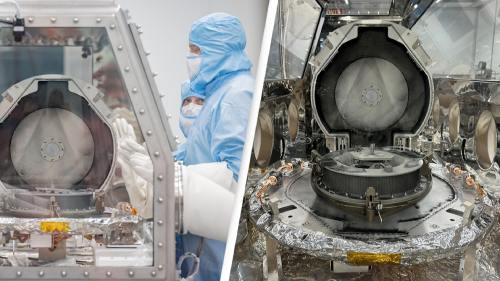“OSIRIS-REx’s Bounty from Asteroid Bennu Surpasses Expectations, Prolonging Sample Collection”
NASA’s OSIRIS-REx mission, aimed at collecting samples from asteroid Bennu, has encountered an unexpected but exciting challenge: an abundance of material has filled the sample collection system beyond expectations. This unexpected surplus has temporarily slowed down the curation process, but it promises a wealth of scientific discoveries.
The initial phase of curating NASA’s OSIRIS-REx sample from asteroid Bennu has begun more gradually than anticipated due to the sheer volume of material collected. The TAGSAM (Touch-and-Go Sample Acquisition Mechanism) head, which contains the majority of the asteroid material, is being carefully disassembled, with meticulous attention to detail.
Unforeseen Discoveries
Following the collection event on Bennu three years ago, scientists anticipated finding some asteroid material outside the TAGSAM head, as particles had been observed slowly escaping before it was sealed. However, the actual quantity of dark particles covering the inside of the canister lid and base, surrounding the TAGSAM, exceeds their expectations.
Christopher Snead, deputy OSIRIS-REx curation lead at NASA’s Johnson Space Center, remarked, “The very best ‘problem’ to have is that there is so much material, it’s taking longer than we expected to collect it. There’s a lot of abundant material outside the TAGSAM head that’s interesting in its own right. It’s really spectacular to have all that material there.”
Sample Analysis
The first sample collected from the avionics deck, outside the TAGSAM head, is currently undergoing a quick-look analysis by scientists. This preliminary examination will offer initial insights into the composition of the Bennu material and provide a glimpse of what the bulk sample might contain.
Lindsay Keller, a member of the OSIRIS-REx sample analysis team from Johnson, explained, “We have all the microanalytical techniques that we can throw at this to really, really tear it apart, almost down to the atomic scale.” The quick-look analysis employs various instruments, including a scanning electron microscope (SEM), infrared measurements, and X-ray diffraction (XRD), to gain a comprehensive understanding of the sample.
The SEM will provide both chemical and morphological analyses, while infrared measurements will help determine the presence of hydrated minerals and organic-rich particles. X-ray diffraction will identify the different minerals present in the sample and potentially reveal their proportions.
Keller emphasized the expertise and cutting-edge tools being utilized in this research, saying, “You’ve got really top-notch people and instruments and facilities that are going to be hitting these samples.”
The quick-look analysis serves as a valuable tool to provide additional data for researchers as they prepare for more in-depth analysis of the larger sample fragments.
What’s Next
In the upcoming weeks, the curation team will transfer the TAGSAM head to a specialized glovebox to commence the intricate process of disassembling it, ultimately revealing the bulk sample contained within. This next phase represents a crucial step in unraveling the mysteries of asteroid Bennu and unlocking its scientific treasures.
Disclaimer: The views, suggestions, and opinions expressed here are the sole responsibility of the experts. No Zoomer Zest journalist was involved in the writing and production of this article.





